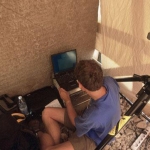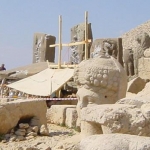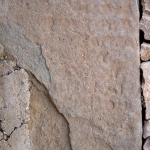The Master Plan incorporated the production of squeezes, replacing the ones Puchstein made in 1883. Traditional squeezes were made of the texts.
The epigraphy team conducted research with a modern digital scanner; a Minolta VI-900 non-contact scanner that uses a laser to determine the surface topography. Simultaneously, the camera measured the colour of each recorded point in order to create a texture. Approximately 300,000 measuring points were recorded per scan. The next step was to render the topography of the reliefs in the form of a TIN raster (triangular irregular network) and feed the data into the SIS. One of the objectives was to read the deleted, older texts on the reliefs. Unfortunately the epigraphy team could not finish their job.






